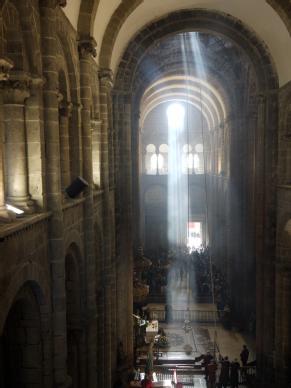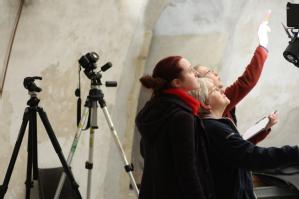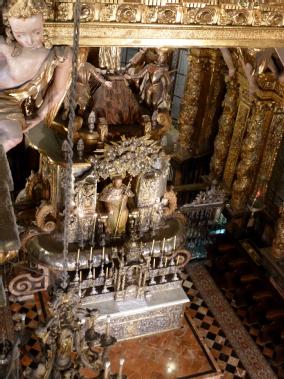Reconstructing Medieval Construction
Reconstructing Medieval Construction by Dr Jenny Alexander (History of Art)
|
We have just published our work on the early phases of the cathedral of Santiago de Copostela, the site of the shrine of St James and the end of the camino, the pilgrimage route across northern Spain from the Pyrenees. I was co-investigator on the project, funded by the regional government of Galicia, and was responsible for a stone by stone survey of the masonry of the area around the cathedral’s high altar. Other members of the project studied the sculpted capitals, and the project’s brief was to gain a better understanding of the progress of construction of its earliest parts. We were all held up by the fall-out from the theft of the famous Codex Calixtinus from the cathedral’s treasury and when we finally gained clearance to start work we were faced with a whole new set of rules and regulations about access and working times. Fortunately the security guards were friendly and became interested in what we were doing, even joining us when they had a spare moment, but we were now working against a very short deadline. My team recorded the marks made by the stonemasons on the walling stone, and it soon became apparent that we needed more people, so I called on three ex-students from the History of Art department and we were able to get a great deal of work done in the reduced time that we had. Working in a great cathedral after hours is a strange experience, sometimes we were the only people there and it made a stark contrast to the rest of the time when the building could be filled with people and with the sounds, and smells, of the services. Compostela has a spectacular addition to its noon-time pilgrim mass when the Botafumero, the great incense-burner, is swung through the building. It is so large that it takes nine men to haul on the ropes to get it moving and it is a moment of pure theatre, complete with a series of little rituals for lighting the incense, and for slowing down and catching the burner at the end. We had a very priviledged view of the whole thing from the galleries upstairs. Recording the marks involved locating, identifying and relating them to a site grid, with photographs of all the marks and their sites. The next stage was to code the information and enter it into a database so that we could see the distribution patterns of the different marks. We were also able to see how the masons worked together in teams, to assess the significances of changes in the design of the building and comment on the length of breaks in building activity. Our main challenge was to deal with the massive Baroque altar that dominates the centre of the choir, and with the attendant cladding of the inner faces of the walls around, both of which limited the amount of material we could record. We did discover that some of it wasn’t very closely fitted however, and with a strong light and a certain amount of dexterity on the recorder’s part we did make some discoveries. My Spanish colleague translated our analysis into perfect Spanish, as that is the language we have had to publish in since the financial situation of the country made the usual multi-lingual co-publication impossible. We fully intend to publish an English version when funding permits, and we also hope to be able to go back to Compostela and continue our work on the rest of the building.
|



